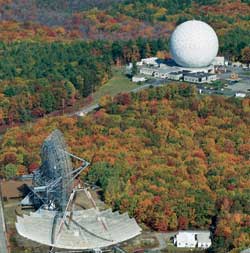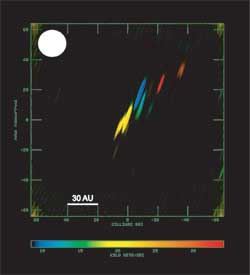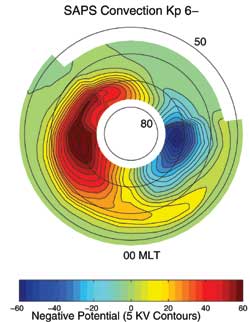| home this issue archives editorial board contact us faculty website |

| Vol.
XVI No.
5 April / May 2004 |
| contents |
| Printable Version |
Research at MIT
Haystack Observatory
Haystack Observatory is a multidisciplinary research center engaged in radio astronomy, geodesy, and upper atmospheric physics. The Observatory's facilities are located off campus, on 1300 acres of hilly woodlands 40 miles northwest of Cambridge, in Westford, Massachusetts. The research programs and operations of the Observatory's radio telescopes and radars are conducted by a group of 100 research scientists, engineers, and technical personnel. Parts of Haystack's research programs are carried out in collaboration with faculty and staff on campus and at area universities which form the Northeast Radio Observatory Consortium (NEROC). Some of the facilities at the Observatory are shared with Lincoln Laboratory for its space surveillance program.

The primary Haystack Observatory observing instruments include a 37-meter diameter radio telescope and radar housed in the large dome (top of photo, Figure 1), a 67-meter zenith-pointed antenna, and a 45-meter steerable antenna (bottom of photo) that are part of the high-power Millstone Hill radar used to probe the Earth's upper atmosphere. A major upgrade of the 37-meter antenna is now being undertaken by Lincoln Laboratory to enable radar operations at 95 GHz for satellite imaging with fine resolution, and the upgrade is expected to benefit radio astronomical research in the future.
Current Research Emphasis
In the quest for higher sensitivity and higher resolution, radio astronomical observations have generally moved from single-dish apertures to arrays of antennas, and Haystack Observatory has been leading several of these developments. An array of 25 stations, each consisting of 24 dipole antennas and digital receivers tuned to 327 MHz, is under construction at Haystack to detect the emission line of Deuterium. Deuterium is a sensitive indicator of the density of baryons that relates to the amount of dark matter in the universe. The array is nearly complete and deep integrations of this faint line, so far undetected by radio techniques due to the lack of adequate sensitivity, will begin later this year.
Design work for the first fully digital radio telescope - an array of low frequency dipole antennas covering 10 to 250 MHz - has been progressing with the expectation that a demonstrator system will be constructed in the next few years prior to the implementation of the full array of 100 stations, preferably in the outback of Western Australia, where radio frequency interference from man-made noise is very low. The project, a collaborative effort with the Center for Space Research, is aimed at characterizing the epoch of re-ionization during the formation of the early universe, detecting transients at radio frequencies such as from gamma-ray bursts and pulsars, and investigating various heliospheric phenomena, particularly the magnetic fields of plasma perturbations in the solar wind.
| Back to top |
Haystack Observatory has also continued to advance the technology and application of Very Long Baseline Interferometry (VLBI), where global arrays of radio telescopes are linked together to yield high resolution images of galaxies and to study Earth's orientation parameters. Pioneering experiments at frequencies of 129 GHz and 230 GHz using telescopes in Arizona and Spain equipped with Haystack's new wideband recording technology, have resulted in the successful detection of interferometric fringes on extragalactic radio sources with a resolution of 34 micro-arcseconds - a world record! In addition, emission from silicon monoxide masers in high rotational transitions was imaged around several stellar sources, including the evolved star VYCMa as shown in Figure 2.

The high excitation temperature required for this astronomical maser action places these masers very near the stellar surface, making them unique probes of kinematics at only a few stellar radii. A "line" of maser regions towards VYCMa is observed, suggesting that this high frequency transition may trace the innermost regions of a nearly edge-on circumstellar disk that is oriented in the SE-NW direction. Such a disk has been hypothesized to be the cause of a well-known asymmetric reflection nebula surrounding the star.
Technology advances in VLBI achieved by Haystack engineers have focused on the enhancement of the bandwidth of recorded signals to improve the sensitivity of astronomical and geodetic observations. These advances include the development of magnetic disk recording systems capable of recording at rates of 1 Gbit/s, that have now been implemented at telescopes worldwide, and the development of high speed digital correlators to process the measurements. In an effort to eliminate all data recording, further expand the measurement bandwidth, and process measurements in near real time, the transport of data on commercial optical fiber networks is being exploited, and protocols for sharing these networks with other users are being developed in a collaborative project with researchers from the Laboratory for Computer Science. Recent successful tests from Haystack Observatory to Goddard Space Flight Center and the Onsala Space Observatory in Sweden, have demonstrated the feasibility of this approach.
| Back to top |
The Haystack Observatory program in upper atmospheric physics is based on the measurement of incoherent radar backscatter from Earth's ionosphere to determine the plasma density, temperature and velocity at altitudes from 100 to 1000 km, and across a wide latitude band to the north and south of the Observatory. Emphasis has been recently given to the investigation of the variation of these parameters as a result of geomagnetic storms caused by the impact of coronal mass ejections from the Sun on the Earth's magnetosphere. During such events, large enhancements of plasma temperature reaching several thousand degrees are observed, and are believed to be caused by Joule heating generated by intense electric fields that are measured to be in excess of 50 mV/m compared to a few mV/m during quiet conditions.

During the disturbed conditions, energetic particles are driven into the inner magnetosphere, and these drive currents into the ionosphere at middle latitudes that result in the formation of a region of strong electric fields. Millstone Hill radar observations reveal the persistent nature of these fields which span the night sector equatorward of the auroral two-cell pattern, as illustrated in Figure 3. In addition, steep gradients in plasma density are detected at the peak altitude of the ionospheric layer causing serious propagation effects on satellite communication signals - effects that are part of what has been termed as "space weather."
Education and Outreach
Haystack's research programs and facilities offer excellent training opportunities for students and junior scientists, particularly in instrumentation development. Graduate students and post-doctoral researchers are supported under the various array development projects, and undergraduates participate in internships that provide them with valuable research experiences.
A special program is also conducted to introduce undergraduates to radio astronomy through the use of a small radio telescope and by remote access to the 37-meter radio telescope via the internet. The small radio telescope, consisting of a two-meter antenna and a digital receiver, was developed at Haystack as a learning kit and has now been disseminated to about 80 colleges and universities nationally and internationally, together with special Web-based project materials.
As part of its outreach program to local area schools, Haystack Observatory supports summer internships for science teachers, and its staff members mentor high school students and interact with the neighboring communities through public lectures, tours of the facility, museum exhibits, and visits to classrooms. We welcome visits by MIT faculty, staff, and students to the Haystack Observatory at any time, and further information on our programs and facilities can be found at http://www.haystack.mit.edu/ .
| Back to top | |
| Send your comments |
| home this issue archives editorial board contact us faculty website |